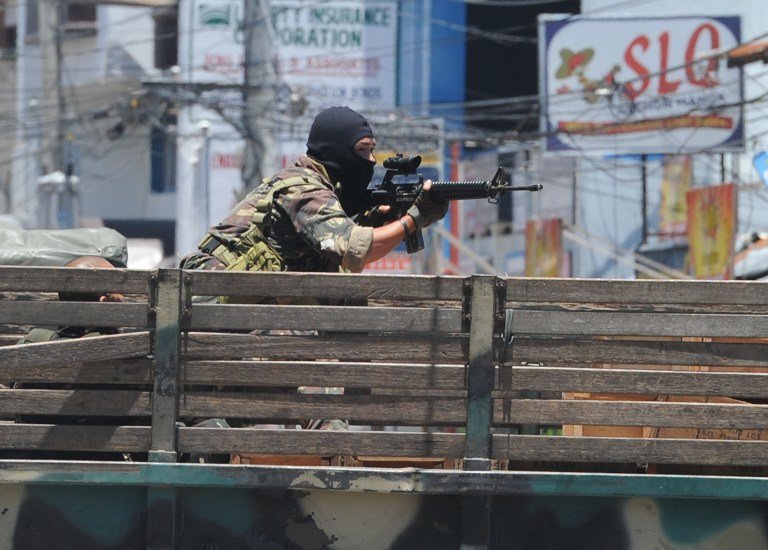SUMMARY
This is AI generated summarization, which may have errors. For context, always refer to the full article.

ZAMBOANGA CITY, Philippines (UPDATED) – Government troops Sunday, September 15, closed in on Muslim rebel positions and cut off escape routes to end a week-long standoff that has left more than 60 people dead in the southern city of Zamboanga, officials said.
Sporadic clashes continued as soldiers moved to clear Moro National Liberation Front (MNLF) gunmen from coastal neighborhoods after a ceasefire plan collapsed, with thousands more residents fleeing to safety.
As troops moved through Brgy Santa Barbara on Sunday, the extent of the damage from 7 days of fighting came into full view, with buildings reduced to smoldering heaps or pockmarked with bullet holes, an Agence France-Presse reporter said.
Soldiers recovered the bodies of two slain gunmen still clinging to their rifles, and several unexploded warheads for use in rocket propelled grenades had been left behind by the fleeing rebels.
In the distance, black smoke billowed from another area that had just gone up in flames.
And in a nearby district, a group of soldiers could be seen crouched on the street as sniper fire whizzed just above their heads, television footage showed.
“We are continuing to press forward with our calibrated military response,” military spokesman Lieutenant Colonel Ramon Zagala told Agence France-Presse.
“Fighting is continuing as we speak. They continue to resist and conduct offensive actions against us.”
Paralyzed city
Heavily armed MNLF forces entered the port city’s coastal neighborhoods Monday, September 9, and took dozens of hostages in a bid to scupper peace talks between another militant group and the government aimed at ending a decades-long rebellion in the south.
But Zagala said the fighting was now concentrated in two coastal districts, while other areas were secure.
But the attack underscored the complexity of ending conflict in the southern third of the mostly Catholic Philippines, where there are several armed Muslim factions and which has seen a proliferation of unlicensed firearms.
Day and night operations by at least 3,000 elite government troops have now seen 51 MNLF rebels killed, as well as six soldiers, a policemen and four civilians.
WATCH: Zamboanga City, land of strife
Air and sea ports remained closed Sunday in a crisis that has paralyzed the city of one million, seen entire neigborhoods razed to the ground, and forced tens of thousands to flee.
The local chamber of commerce said economic losses in Zamboanga, home to a major sardine canning industry, could be as much as Php 50 billion ($1.1 billion) a day.
Police on Saturday, September 14, estimated that the gunmen were holding as few as seven civilian hostages, compared to more than 100 a day earlier, with many either escaping or being allowed to go free.
Social Welfare Secretary Corazon Soliman said the number of people who had fled to temporary shelters had risen to more than 69,000 by Sunday morning.
READ: Bakwet: The darker side of the Zamboanga crisis
“The number swelled yesterday because thousands more evacuated from areas the rebels were likely to use as escape routes,” she told Agence France-Presse.
“We hope they will be able to go home in the coming week,” she said, while stressing that it was too early to say if the fighting would be over by then.
Abandoned ceasefire
A ceasefire plan brokered by Vice President Jejomar Binay and MNLF leader Nur Misuari was abandoned Saturday, after the two sides failed to agree terms.
READ: Q and A: Binay in Zambo: What happened?
READ: PNoy to Zambo refugees: You are not alone
The MNLF waged a 25-year guerrilla war for independence before signing a peace treaty in 1996 that granted limited self-rule to the south’s Muslim minority.
Misuari, who has accused the government of violating the terms of a 1996 treaty by negotiating a separate deal with a rival faction, had disappeared from public view shortly before the fighting began Monday.
The rival faction, the Moro Islamic Liberation Front (MILF), is in the final stages of peace talks with Manila and is expected to take over an expanded autonomous Muslim region in the south by 2016.
President Benigno Aquino III said the peace talks with the MILF aimed to end decades of rebellion that had claimed 150,000 lives in the country’s Muslim southern regions. – Rappler.com
Add a comment
How does this make you feel?
There are no comments yet. Add your comment to start the conversation.